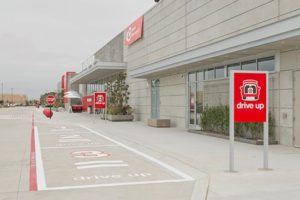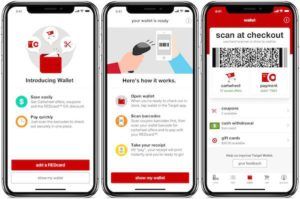Target Transforms for the Digital Age

Target was slow to get on the e-commerce bandwagon. The retailer has spent the past several years working feverishly to catch up, in part by leveraging the value of its physical assets.
As is the case for most retailers that built their brand in brick-and-mortar stores, the past decade has solicited some soul searching for Target. The company achieved Fortune 50 status (rising as high as number 23 in 2004[i]) thanks to its cheap chic merchandise (garnering the nickname “Tar-zhay”) and cheerful stores. But the shifting retail landscape has raised doubts about Target’s ability to maintain its position as an industry leader.
Many of the challenges that Target faces today stem from the fact that they were slow to recognize and embrace the e-commerce trend. In fact, Target’s website and fulfillment operations were managed by Amazon from 2003 to 2011, meaning that Amazon earned a commission on Target.com sales.[ii] Outsourcing those activities for so long demonstrates that Target initially viewed e-commerce as merely an ancillary service that they had to offer, not one that was worthy of significant investment. Unsurprisingly, once Target finally brought its website operations in-house in the fall of 2011 they had a lot of catching up to do. Case in point: the website crashed twice in a six-week span shortly after Target began managing it internally.[iii]
While Target’s late arrival to the e-commerce party granted their rivals a head start, there were and still are opportunities for them to thrive in the age of digital transformation. As we saw in the JD.com case, the future of retail likely isn’t exclusively e-commerce. Rather, the future is likely to resemble JD’s vision of “boundaryless retail” in which consumers shop seamlessly across online and offline channels.[iv] Target’s existing offline infrastructure of nearly 2,000 stores throughout the U.S. positioned them to succeed in that boundaryless retail world if they could find ways to seamlessly integrate digital experiences.
Any discussion of what Target must do to succeed from today forward must start by acknowledging all that they’ve done since taking on their website operations from Amazon in 2011, because they have achieved a lot since then. Beyond the fundamental task of improving website performance, one of Target’s most significant changes has been modernizing its supply chain by integrating its store and digital inventories and developing capabilities to fulfill online orders from stores. For example, customers can choose to place an order online and pick up the items at their local store. Additionally, several hundred stores are now serving as miniature fulfillment centers, shipping hundreds of orders per day to guests’ homes. This means that an item that used to ship to a guest from a fulfillment center located across the country can instead ship from a store across town. This reduces shipping costs, improves delivery speed, and allows the company to fulfill orders even when the fulfillment center is out of stock. These new fulfillment capabilities are already having a massive impact: 70% of Target’s order volume during November/December 2017 was fulfilled from stores.[v]
Recently, Target has been taking its fulfillment capabilities further with several new initiatives. They’re rolling out a “Drive Up” service in which customers’ online orders are brought outside and loaded into their car by employees in a process that takes only about three minutes.[vi] That’s a convenience that Amazon can’t offer today (although their Whole Foods acquisition could change that). Target also recently acquired Shipt, a delivery service company, and is using them to roll out a same-day delivery service to compete with Amazon’s Prime Now.[vii] Again, Target’s physical footprint is a key asset in enabling them to quickly roll out that type of service.

Target is also rethinking the in-store experience for the digital age. The company remodeled over 100 stores in 2017 and will spend billions of dollars remodeling 500 more in 2018 and 2019 with the ambitious goal of providing a shopping experience that is both more convenient and more inspiring.[viii] They’re also rolling out more small-format stores in cities and college campuses[ix], providing convenient locations for both grab-and-go shopping and picking up digital orders. Having physical locations in these densely populated areas should allow them to attract younger, more digitally savvy customers. Additionally, Target has been busy improving its app to enhance instore experiences. Their new wallet feature allows customers to complete a payment that incorporates their credit card, coupons, and gift cards all in a single scan, enabling a checkout experience that is four times faster.[x] And next they’re planning to roll out functionality that will use Bluetooth-powered Beacons to provide a real-time map of the store on the customers’ app.[xi] The map will guide customers to specific items and point them towards deals in the nearby aisles.[xii] These types of investments demonstrate that digital innovation in retail extends well beyond e-commerce.

Target has been rewarded for this transformation with strong digital results. The company has achieved at least 25% sales growth in the digital channel in each of the past four years.[xiii] Digital still makes up a small portion of total revenue – it was 4.3% of their total sales in Q2 2017[xiv] and 8.2% of the total in Q4 2017[xv]. But in an industry in which an extra 1% of overall growth can be the difference between a strong year and a disappointment, 25% growth on even a small portion of the business is significant. The company has also found that customers that shop in both stores and digital channels drive significantly more revenue and profit than other customers[xvi], further demonstrating the value of creating an environment that allows customers to shop seamlessly across all channels.
One of the challenges that faces Target now is managing profitability. It should come as no surprise that the ambitious digital agenda that I’ve described briefly in this post has been very expensive to execute, as evidenced by their Q4 earnings report. Despite beating sales expectations, Target fell slightly short of EPS estimates, causing its share price to drop.[xvii]
Overall, I think Target is taking the right approach regarding spending on digital capabilities. They’ve done an admiral job working to catch up after their slow start in digital. Pinching pennies to hit short-term targets could slow their progress once again. That said, I do sometimes worry that Target is trying to match Amazon on every conceivable dimension, which could be a mistake. I view Target and Amazon as being horizontally differentiated retailers, meaning that even if they sold goods for the same price some customers would prefer the experience of shopping with one company and some would prefer the other. Given that market condition, I think it’s important that Target prioritize investment towards the things that their customers value most. For example, investment in new in-store digital experiences, fulfillment capabilities that allow customers to purchase store inventory digitally, and unique owned brands all seem like things that could differentiate Target and keep customers coming back. Conversely, I don’t know that I see Target getting so good at same-day delivery that they’ll be able to differentiate themselves from Amazon on that dimension. Thus, when prioritizing investments that might be one where I would be willing to invest less aggressively. I certainly wouldn’t want them to get so caught up in the race to match Amazon on every single fulfillment service that they invest less in something like the development of unique owned brands, an investment that may seem less sexy because it was part of the strategy long before the digital age but one that remains a significant source of differentiation.
Organizationally, while it seems clear that Target’s top executives are fully committed to the importance of digital transformation, they could still face some challenges in making sure that employees whose responsibilities span both stores and digital sales channels are motivated to invest sufficient time/effort into digital initiatives. For example, if an employee oversees merchandising for a product category for which only 4% of total sales currently come from digital, how are they likely to allocate their efforts between trying to grow that sliver of digital sales vs. focusing on the massive sales volume coming from stores? It seems like there would be short-term incentive to focus primarily on store sales. But if all merchants took that approach the company’s future growth could be stifled. I’m not sure how the company’s incentive packages are structured for such employees, but one suggestion would be to tie a certain portion of the employee’s bonus directly to digital results (rather than just total category results across all channels) to reduce short-term incentives to neglect digital. Some might argue that you could also achieve this goal by assigning separate employees to oversee store vs. digital activities for each product category. However, I think increasing channel silos would make it even more difficult to achieve the seamless omni-channel experience that customers increasingly expect from retailers.
Target has come to embrace digital transformation, and the company’s future is much more promising because of that shift. Target’s former Chief Digital Officer Jason Goldberger liked to say, “Target.com is not going to beat Amazon.com. Target is going to beat Amazon.com.”[xviii] While I don’t think any retailer is positioned to “beat” Amazon, I do agree that by fully leveraging its physical assets in coordination with new digital capabilities Target is positioning itself to remain a retail force for years to come. Long live Tar-zhay!
BONUS CONTENT
This recent article contains some insightful quotes from Target’s CEO Brian Cornell and COO John Mulligan that exemplify how they think about the role of physical stores in the digital age: https://diginomica.com/2018/03/07/loving-store-puts-digital-transformation-target-looking-cybermonday-bullseye-year/
This CNBC video covers some of the investor concerns in regards to Target’s expense levels in their Q4 earnings report: https://www.cnbc.com/video/2018/03/06/targets-revamp-sparks-concern-over-costs.html
[i] http://fortune.com/fortune500/target/
[ii] http://fortune.com/2015/05/28/target-amazon-thanks/
[iii] https://www.reuters.com/article/us-target/target-website-crashes-for-second-time-in-six-weeks-idUSTRE79O6XJ20111025
[iv] Zhu, Feng and Shirley Sun. JD: Envisioning the Future of Retail. Harvard Business School Publishing. 9 April 2018.
[v] https://corporate.target.com/article/2018/01/brian-cornell-holiday-2017-update
[vi] http://www.startribune.com/analyst-gives-target-s-drive-up-service-in-twin-cities-a-thumbs-up/476590863/
[vii] http://m.startribune.com/target-will-roll-out-same-day-delivery-in-twin-cities-next-month-as-it-faces-off-with-amazon/473666723/
[viii] https://corporate.target.com/article/2017/03/reimagined-target-stores
[ix] Ibid.
[x] https://www.engadget.com/amp/2017/12/04/targets-app-pairs-coupons-credit-card-faster-checkout/
[xi] https://www.engadget.com/2017/09/20/target-app-will-guide-you-to-items/
[xii] Ibid.
[xiii] https://www.cnbc.com/2018/03/06/target-q4-earnings-2017.html
[xiv] https://www.digitalcommerce360.com/2017/08/16/target-rings-700-million-online-sales-q2/
[xv] https://www.cnbc.com/2018/03/06/target-q4-earnings-2017.html
[xvi] http://fortune.com/2015/05/28/target-amazon-thanks/
[xvii] Ibid.
[xviii] https://www.chainstoreage.com/article/how-target-can-beat-amazon/


